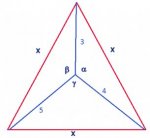slice_of_god
New member
- Joined
- Nov 5, 2013
- Messages
- 6
it's a Equilateral triangle.
find the "X".
thank you.

find the "X".
thank you.


How is the x that you are supposed to find defined?it's a Equilateral triangle.
find the "X".
thank you.

Is it possible that \(\displaystyle x\) is the side of the triangle?How is the x that you are supposed to find defined?
What have you tried?
yes i know the law of cosines.Is it possible that \(\displaystyle x\) is the side of the triangle?
Is it possible you know the law of cosines?
Show us your work! WE don't know what YOU know!
yes i know the law of cosines.
the X is the side of triangle.

A hint from that solution is that \(\displaystyle \alpha = 90° + 60° = 150°\). If you can prove that somehow, then the problem is solved.Denis said:
